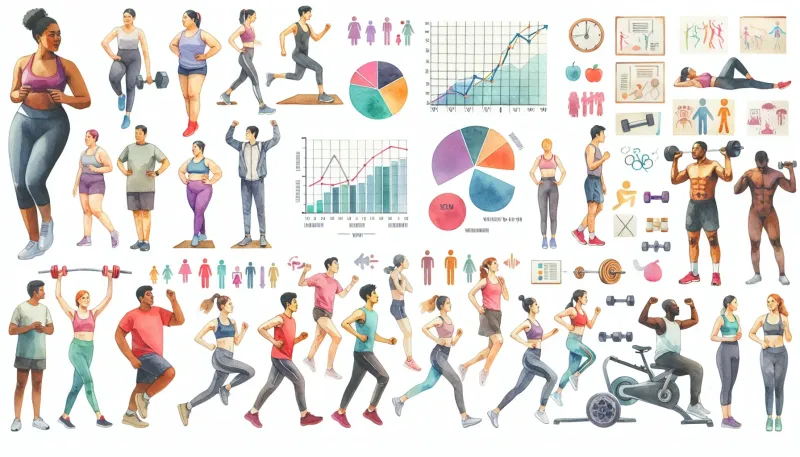The Ultimate Guide to Understanding Waist-to-Hip Ratio and Exercise

Discover the significance of waist-to-hip ratio and exercise, why it matters for your health, and how to maintain an optimal ratio through targeted workouts.
Waist-to-hip ratio (WHR) is a critical metric used to gauge an individual's risk of developing health issues such as cardiovascular disease, diabetes, and metabolic syndrome. Understanding WHR and incorporating specific exercises can help in maintaining a healthy ratio and improving overall well-being. This comprehensive guide explores what waist-to-hip ratio is, how it is calculated, and the exercises that can help optimize your WHR.
What is Waist-to-Hip Ratio?
The waist-to-hip ratio is a measurement that compares the circumference of your waist to that of your hips. It provides insights into fat distribution in the body, which is an important indicator of health risks.
How to Calculate Waist-to-Hip Ratio
- Measure the circumference of your waist at its narrowest point, usually just above the belly button.
- Measure the circumference of your hips at their widest point, typically at the level of the buttocks.
- Divide the waist measurement by the hip measurement to find your WHR.
For example, if your waist is 30 inches and your hips are 40 inches, your WHR would be 0.75.
Why is Waist-to-Hip Ratio Important?
The waist-to-hip ratio is a valuable metric because it helps predict health risks better than BMI (Body Mass Index) alone. A higher WHR indicates more abdominal fat, which is associated with a higher risk of chronic diseases.
Risk Categorization by WHR
- Low Risk: WHR less than 0.80 for women, less than 0.95 for men.
- Moderate Risk: WHR between 0.80-0.85 for women, 0.95-1.0 for men.
- High Risk: WHR greater than 0.85 for women, greater than 1.0 for men.
Maintaining a lower WHR reduces the likelihood of developing conditions such as type 2 diabetes, heart disease, and certain types of cancer.
Exercises to Improve Waist-to-Hip Ratio
Incorporating exercises that target both your waist and hips can help improve your WHR. Here are some effective exercises:
Core-Strengthening Exercises
- Planks: Hold a plank position to engage your core, improving waist strength and stability.
- Russian Twists: Sit with your knees bent and feet off the ground, twist your torso to engage your obliques.
- Leg Raises: Lying on your back, lift your legs to engage the lower abdominal muscles.
Hip-Focused Exercises
- Glute Bridges: Lift your hips while lying on your back to strengthen the glutes and hip muscles.
- Hip Thrusts: Use a bench or platform for hip thrusts to target the glutes effectively.
- Squats: Squats engage the hips, glutes, and thighs, contributing to a balanced lower body workout.
Cardio Exercises for Fat Reduction
- Running: Regular running sessions help reduce overall body fat, including abdominal fat.
- Swimming: A full-body workout that effectively burns calories and reduces fat.
- Cycling: Engages both the lower and upper body, promoting fat loss in key areas.
Creating a Balanced Workout Routine
A balanced workout routine should combine core-strengthening, hip-focused, and cardio exercises. Aim for a mix of these activities throughout the week to see comprehensive improvements in your WHR.
Sample Weekly Workout Plan
- Monday: Core-strengthening (30 minutes)
- Tuesday: Hip-focused exercises (30 minutes)
- Wednesday: Cardio (45 minutes)
- Thursday: Core-strengthening (30 minutes)
- Friday: Hip-focused exercises (30 minutes)
- Saturday: Cardio (45 minutes)
- Sunday: Rest or light activity (e.g., walking)
Nutrition Tips to Complement Your Exercise Routine
Exercise alone is not enough to improve your waist-to-hip ratio. A balanced diet is crucial for optimal results.
Focus on Protein and Fiber
- Lean Proteins: Include sources like chicken, fish, tofu, and legumes to support muscle growth and repair.
- Fiber-Rich Foods: Fruits, vegetables, and whole grains help control appetite and promote digestive health.
Avoid Sugary and Processed Foods
- Limit Added Sugars: Excess sugar contributes to fat accumulation, particularly around the abdomen.
- Avoid Processed Foods: Processed snacks and meals are often high in unhealthy fats and sugars, which can negatively impact your WHR.
Conclusion
Understanding and maintaining a healthy waist-to-hip ratio is essential for reducing health risks and enhancing overall well-being. By incorporating targeted exercises, creating a balanced workout routine, and following proper nutrition guidelines, you can effectively manage your WHR. Stay committed, and you will see significant improvements in both your physical health and appearance.



























